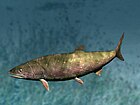The Jurassic is a geologic period and stratigraphic system that spanned from the end of the Triassic Period 201.4 million years ago (Mya) to the beginning of the Cretaceous Period, approximately 145 Mya. The Jurassic constitutes the middle period of the Mesozoic Era and is named after the Jura Mountains, where limestone strata from the period were first identified.

The Triassic–Jurassic (Tr-J) extinction event, often called the end-Triassic extinction, marks the boundary between the Triassic and Jurassic periods, 201.4 million years ago, and is one of the top five major extinction events of the Phanerozoic eon, profoundly affecting life on land and in the oceans. In the seas, the entire class of conodonts and 23–34% of marine genera disappeared. On land, all archosauromorphs other than crocodylomorphs, pterosaurs, and dinosaurs became extinct; some of the groups which died out were previously abundant, such as aetosaurs, phytosaurs, and rauisuchids. Some remaining non-mammalian therapsids and many of the large temnospondyl amphibians had become extinct prior to the Jurassic as well. However, there is still much uncertainty regarding a connection between the Tr-J boundary and terrestrial vertebrates, due to a lack of terrestrial fossils from the Rhaetian (latest) stage of the Triassic. What was left fairly untouched were plants, crocodylomorphs, dinosaurs, pterosaurs and mammals; this allowed the dinosaurs, pterosaurs, and crocodylomorphs to become the dominant land animals for the next 135 million years.
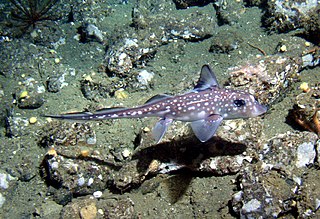
Chimaeras are cartilaginous fish in the order Chimaeriformes, known informally as ghost sharks, rat fish, spookfish, or rabbit fish; the last three names are not to be confused with rattails, Opisthoproctidae, or Siganidae, respectively.

Caturus is an extinct genus of fishes in the family Caturidae in the order Amiiformes, related to modern bowfin. Fossils of this genus range from 200 to 109 mya. It has been suggested that the genus is non-monophyletic with respect to other caturid genera.

Charles Stewart, better known as Chali 2na, is an American painter and rapper, associated with the groups Jurassic 5 and Ozomatli. He is known for his bass-baritone and quick delivery rapping style.
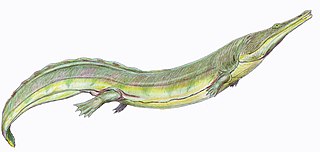
Trematosauroidea are an important group of Triassic temnospondyl amphibians. They flourished briefly during the Early Triassic, occurring worldwide before declining at the start of the Middle Triassic, although the group continued until the Late Triassic. They were medium-sized temnospondyls with wedge-shaped tails, narrow skulls, and, in advanced forms, elongated snouts. The latter feature was probably an adaptation for feeding on fish. The largest and most specialized family, the Trematosauridae, are the only batrachomorphs to have adapted to a marine lifestyle with the exception of the modern crab-eating frog.

Jurassic Park, later also referred to as Jurassic World, is an American science fiction media franchise created by Michael Crichton and centered on a disastrous attempt to create a theme park of cloned dinosaurs. It began in 1990 when Universal Pictures and Amblin Entertainment bought the rights to Crichton's novel Jurassic Park before it was published. The book was successful, as was Steven Spielberg's 1993 film adaptation. The film received a theatrical 3D re-release in 2013, and was selected in 2018 for preservation in the United States National Film Registry by the Library of Congress as being "culturally, historically, or aesthetically significant". A 1995 sequel novel, The Lost World, was followed by a film adaptation in 1997. Subsequent films in the series, including Jurassic Park III (2001), are not based on the novels.

Leptolepidae is an extinct family of herring-like stem-teleost fish found throughout the world during the Jurassic. They were among the first fish to possess certain teleost synapomorphies, such as cycloid scales and fully ossified vertebrae.
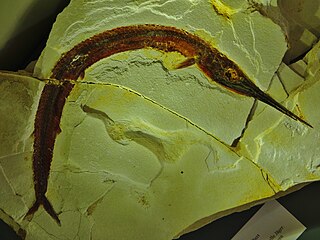
Aspidorhynchiformes is an extinct order of ray-finned fish. It contains only a single family, the Aspidorhynchidae. Members of the group are noted for their elongated, conical rostrums, of varying length, formed from fused premaxillae. They are generally interpreted as stem-group teleosts. The range of the group extends from the Middle Jurassic to the late Paleocene.
Atacamichthys is an extinct genus of ray-finned fish. It contains one species, Atacamichthys greeni, which lived in what is now Chile during the Oxfordian stage of the Late Jurassic epoch. Atacamichthys is the only member of the family Atacamichthyidae.

Varasichthys is an extinct genus of ray-finned fish that lived during the Oxfordian stage of the Late Jurassic epoch. It contains one species, Varasichthys ariasi, fossils of which have been found in the Domeyko Range of Antofagasta Region, northern Chile. It has been placed in the family Varasichthyidae together with the genera Bobbichthys, Domeykos, Luisichthys and Protoclupea.
Protoclupea is an extinct genus of ray-finned fish that lived from the Oxfordian to the early Tithonian stage of the Late Jurassic epoch. It contains one species, Protoclupea chilensis, fossils of which have been found in the Domeyko Range of Antofagasta Region, northern Chile. The genus has been placed in the family Varasichthyidae together with the genera Bobbichthys, Domeykos, Luisichthys and Varasichthys.
Ascalabos is an extinct genus of ray-finned fish known from the Late Jurassic Solnhofen Limestone of Germany. It contains one species, A. voithii.

Saurorhynchus is an extinct genus of carnivorous bony fish. It is the youngest representative of the family Saurichthyidae and the order Saurichthyiformes. This family is known for its large, elongate jaws, similar to modern Belonidae. Saurichthyidae also includes the Permian genus Eosaurichthys and the Triassic genus Saurichthys.

Saurichthyiformes is an extinct order of ray-finned fish which existed in Asia, Africa, Australia, Europe and North America, during the late Permian to early Middle Jurassic. Saurichthyiiformes comprise two families, Saurichthyidae and Yelangichthyidae. Whereas Yelangichthyidae is monotypic, Saurichthyidae includes at least two genera, Saurorhynchus and the very speciose Saurichthys. Additionally, the subgenera Costasaurichthys, Eosaurichthys, Lepidosaurichthys, and Sinosaurichthys are frequently used to group species. Saurichthyiforms were highly successful predators, and with Yelangichthys possibly even included durophagous forms. Species are known from both marine end freshwater deposits. They had their highest diversity during the Early and Middle Triassic.
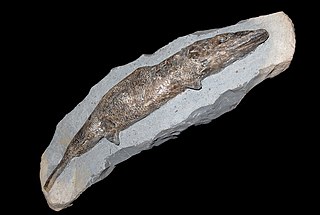
Crossognathiformes is an extinct order of ray-finned fish that lived from the Late Jurassic to the Eocene. Its phylogenetic placement is disputed; some authors have recovered it as part of the teleost stem group, while others place it in a basal position within crown group Teleostei.

Archaeomaenidae is an extinct family of stem-teleost fish found in freshwater environments of Jurassic New South Wales of Australia, China, and Antarctica, and in Lower Cretaceous New South Wales and Mongolia.

Orthogonikleithrus is a genus of extinct ray-finned fish that lived during the Late Jurassic period. It lived in lagoonal and restricted shallow subtidal zones.

Ginglymodi is a clade of ray-finned fish containing modern-day gars (Lepisosteidae) and their extinct relatives, including the family Lepidotidae and the orders Semionotiformes and Kyphosichthyiformes, and various other extinct taxa. Ginglymodi is one of the two major subgroups of the infraclass Holostei, the other one being Halecomorphi, which contains the bowfin and its fossil relatives.
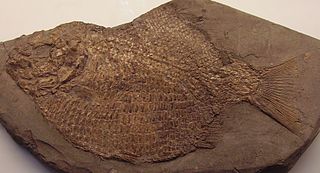
Dapediidae is an extinct family of neopterygian ray-finned fish that lived during from the Late Triassic to Late Jurassic. It is the only family of the order Dapediiformes. Its members were historically placed within the ginglymodian family Semionotidae, but were moved to their own family in 1966.

















